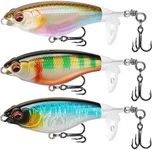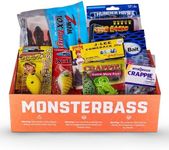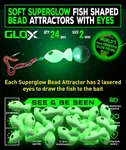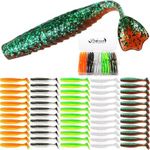Buying Guide for the Best Largemouth Bass Lures
Choosing the right largemouth bass lure can significantly improve your fishing experience and success rate. The key is to understand the different types of lures available and how they work in various conditions. By considering factors such as water clarity, weather, and the behavior of the bass, you can select a lure that will attract more fish and increase your chances of a catch.Lure TypeLure type refers to the design and function of the lure. Common types include crankbaits, spinnerbaits, soft plastics, and topwater lures. Each type mimics different prey and works best in specific conditions. Crankbaits are great for covering a lot of water quickly, spinnerbaits are effective in murky water, soft plastics are versatile and can be used in various situations, and topwater lures are exciting to use when bass are feeding near the surface. Choose a lure type based on the fishing environment and the behavior of the bass.
Lure SizeLure size is important because it affects the lure's visibility and the size of the bass it attracts. Smaller lures (1-3 inches) are ideal for clear water and when bass are feeding on smaller prey. Medium-sized lures (3-5 inches) are versatile and can be used in most conditions. Larger lures (5 inches and above) are best for targeting bigger bass or when fishing in murky water. Consider the size of the bass you are targeting and the water conditions when selecting the lure size.
Lure ColorLure color can make a big difference in attracting bass. In clear water, natural colors like green, brown, and silver are effective because they resemble the bass's natural prey. In murky or stained water, brighter colors like chartreuse, orange, and white are more visible and can attract bass more easily. Additionally, in low light conditions or at night, dark colors like black or blue create a strong silhouette that bass can detect. Match the lure color to the water clarity and light conditions for the best results.
Lure ActionLure action refers to the movement of the lure in the water. Some lures have a wobbling or vibrating action, while others may have a more subtle or erratic movement. The action can trigger a bass's predatory instincts. For example, crankbaits with a wide wobble are effective in warmer water when bass are more active, while a subtle action is better in colder water when bass are less aggressive. Choose a lure with an action that matches the activity level of the bass and the water temperature.
Lure DepthLure depth is the depth at which the lure is designed to run. Some lures are made to float on the surface, while others are designed to dive to specific depths. Surface lures are great for shallow water and when bass are feeding near the top. Shallow diving lures (1-5 feet) are effective in shallow waters or over submerged vegetation. Medium diving lures (5-10 feet) are versatile for various depths, and deep diving lures (10 feet and deeper) are best for reaching bass in deeper waters. Consider the depth at which the bass are likely to be and choose a lure that can reach that depth.






















